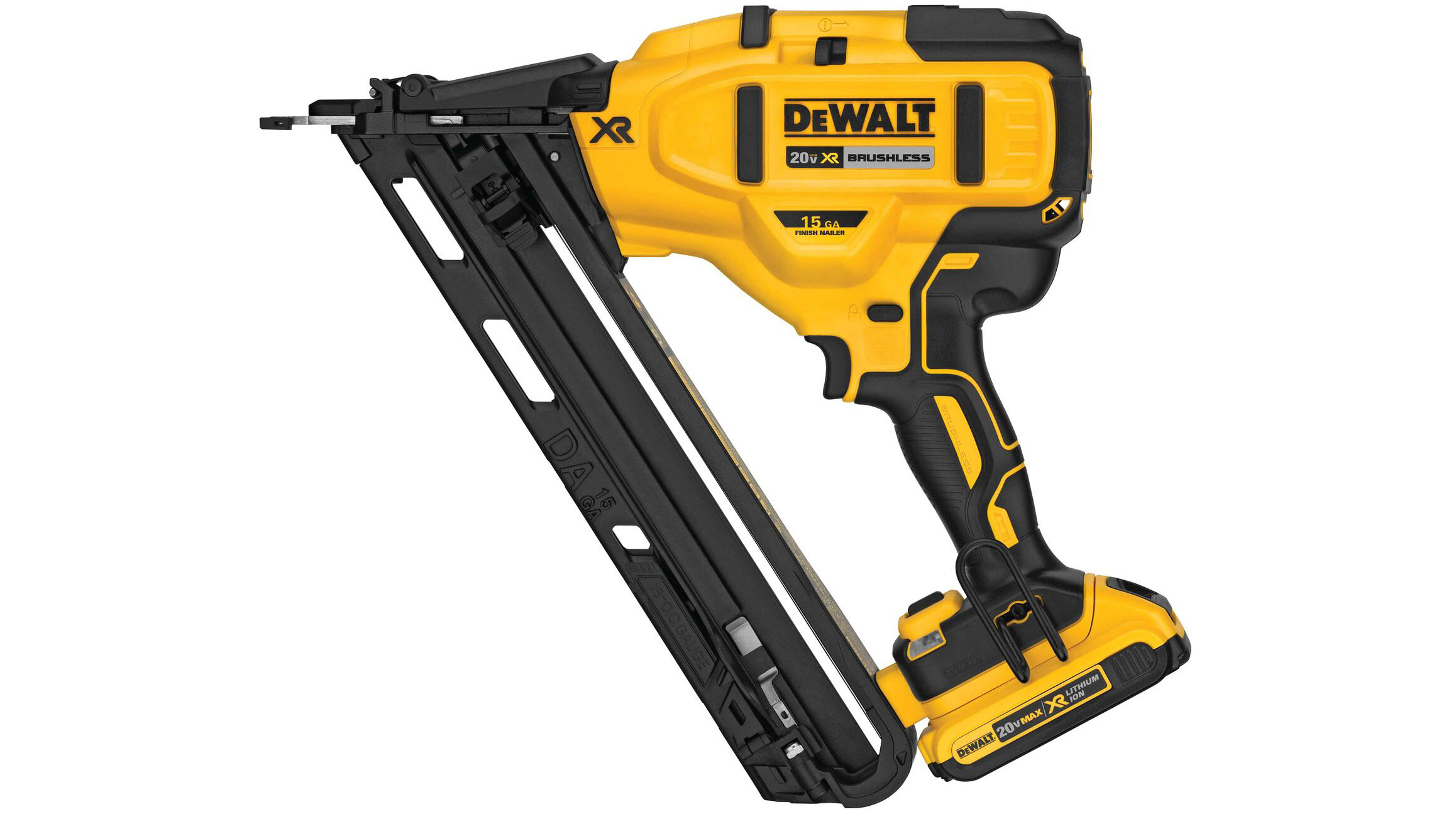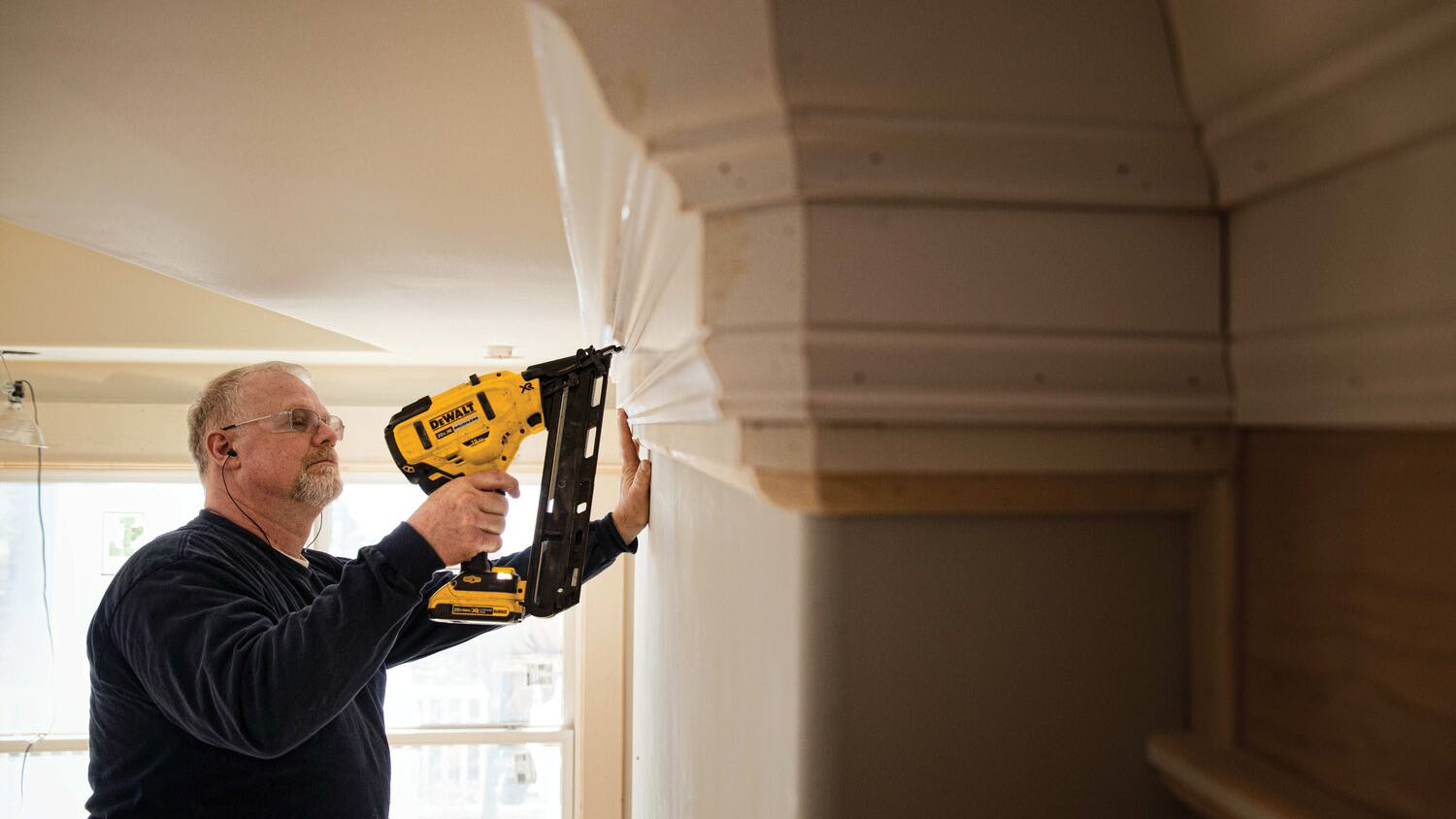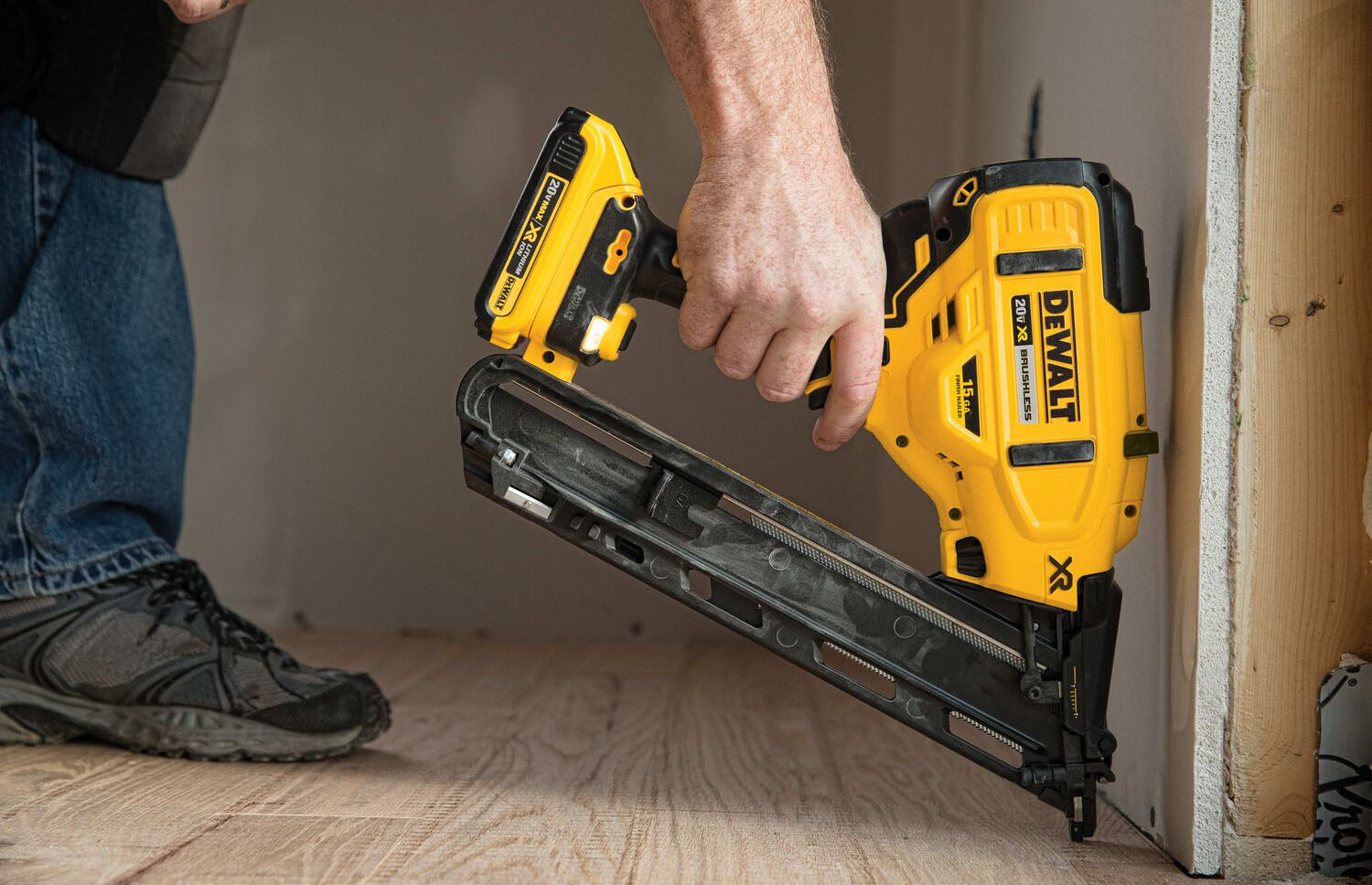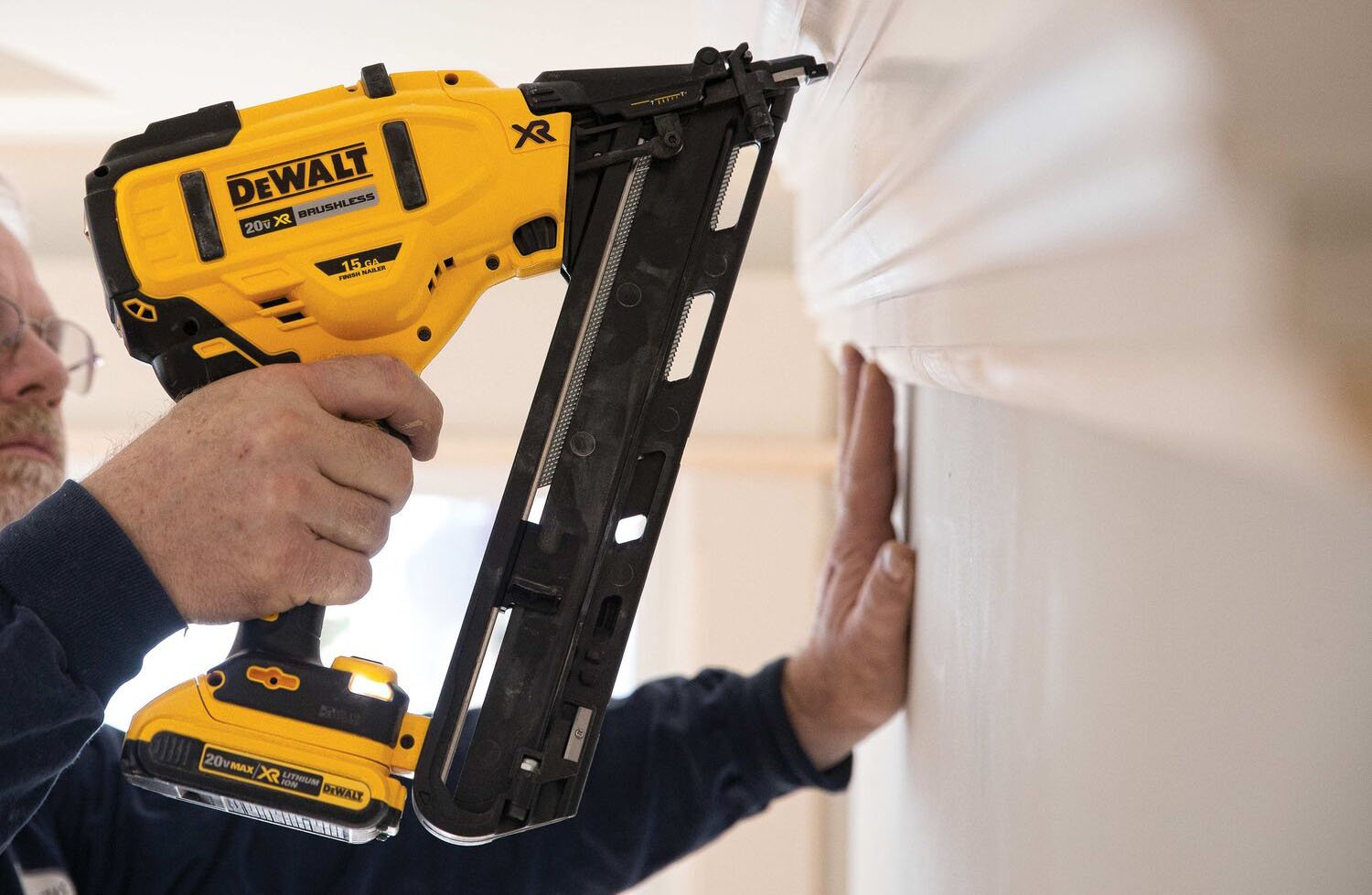When it comes to nailers a 15-gauge tool is the big one. Unlike 18-gauge nailers, which are lighter and fire thinner nails, 15-gauge tools – especially battery-powered versions – are heavier and the fasteners won’t disappear into the grain of the wood. These nails are the fattest and the longest of any nail gun, which explains why the tool is often used to pin trim down to a stud or structure below, where that added length helps penetrate thicker moldings.
They require a little more prep work to cover up those pockmarks with a filler, but when you’re working with bigger wood elements, it’s a tradeoff you make for the peace of mind the work isn’t going to move or the nail won’t pull out. Generally, you’d reach for a 15-gauge tool when you’re mounting wood, MDF, or PVC trim to some structure behind it.
Typically, 15-gauge nailers, depending on the brand, use fasteners from 1 1/4-inch to around 2 1/2-inches long. That minimum length is longer than any other finish nailer and, in some cases, might be too much for smaller woodworking projects. But it’s an indicator that a 15-gauge nailer is for the biggest interior and exterior carpentry projects.
Now that you’re familiar with the kinds of carpentry tasks the DeWalt 20V Max XR 15-Gauge Angled Finish Nailer is designed to take on, read on to see how it performed in our testing and whether it should be up there with the best power tools.

The DeWalt DCN650D1 20V Max XR 15-Gauge Angled Finish Nailer specifications:
- Gauge: 15
- Nail length: 1.25–2.5 inches long
- Run time: drives about 700 nails per charge
- Power: cordless (20-volt 2.0Ah compact battery)
- Weight: 5.8lbs with battery
Choosing a 15-gauge nail gun
The 15-gauge nailer is the burliest of the tools in the category, so it means that DIYers will call on it less often than an 18- or 16-gauge tool. But for big jobs – where you're renovating new construction for example – it's invaluable.
Many carpenters and flooring contractors keep the 15-gauge tool as part of their daily use, but homeowners might not see the value in it unless their skills have surpassed installing basic, skinny builder-grade trim to talking chunkier crown, baseboard, or hanging a door. That's when springing for a 15-gauge tool makes more sense.
Likewise, if you plan on installing your hardwood flooring, renovating a stairway, working on other trim projects like a plate or chair rail or an elaborate fireplace mantle, the tool might be worth the upgrade.
Who does the DeWalt DCN650D1 20V Max XR 15-Gauge Angled Finish Nailer suit?
Despite their beefy, long nails, modern battery tech and design enable these 15-gauge tools to operate on battery power alone, so a compressor isn’t required. For homeowners that means fewer components to purchase.
Nearly every major power tool manufacturer – including DeWalt – offers a 15-gauge nailer as a kit, paired with a battery and charger, or just the tool itself. If you’ve already invested in a specific brand’s power tools you can save quite a bit by buying a 15-gauge nailer as a 'bare tool' which helps reduce the clutter of unnecessary chargers. Therefore, if you have other tools in the DeWalt family, this is a first reason to choose this nailer. There are also options to buy it as a kit with a case and spare batteries if preferred, and DeWalt offer bundles with some of their other battery compatible tools such as drills.
Typically, most 15-gauge tools come with an angled design. Once you’ve opted to go with a battery-powered tool, you'll need to understand what type of nail it fires: 'DA' or 'FN'. That decision doesn’t influence the performance of the tool – both fastener styles work well and come in the same range of lengths and most home centers carry both. Note that the DeWalt DCN650D1 20V Max XR 15-Gauge Angled Finish Nailer uses DA type nails, offering a rounder head than FNs.
Looking for a more affordable brad nailer for baseboard and molding? I reviewed the Ryobi One+ 18 Volt Cordless Airstrike 18-Gauge nailer, that might be better suited to the average DIYer's range of tasks.

What is the DeWalt 20V Max XR 15-Gauge Angled Finish Nailer like to use?
If you have used smaller gauge nailers the first thing you’ll notice when you pick up the DeWalt 15-Gauge Angle Finish Nailer is the size. This tool is big. It’s more than a foot tall and wide, and while the magazine is angled in line to help with better access in corners, it can take some getting used to if you’re working on the floor, overhead, or in a pre-hung door opening. Though it's a quick learning curve.
If you're used to traditional, compressor-driven tools, the DeWalt is a hair slower, like most battery-powered tools, but is up to the task for every nailing job. The nailer is fast, accurate, consistent, and easy to use.
But handling the size is just about the most difficult part of using the DeWalt. Despite the bulky build, the tool's ergonomics are exceptional. The handle is very comfortable and enables you to hold the tool in various positions, including upside down where you'd pull the trigger with your pinkie. The nosepiece is narrow which helps with the consistency of nail placement.
The LEDs, which are mounted low on the tool, do a good job of illuminating the work surface in low-light situations like a closet. The design of the nailer allows it to sit upright when set down, a tiny detail that makes the tool easier to use and set down.

What nails do you need for the DeWalt DCN650D1 20V Max XR 15-Gauge Angled Finish Nailer?
As stated before, unlike other nailers, you have to pay closer attention to the style of fastener with 15-gauge angled guns. There are two main styles of nails and they are not interchangeable. If you don't pay attention, you can pick up a pack of 15-gauge nails and there is a chance they might not work with your tool.
The DeWalt DCN650D1 20V Max XR 15-Gauge Angled Finish Nailer uses 'DA' style nails, where the nails nest together with a slight D shape to the head. These have a 34-degree angle. 'FN' style heads have a blockier, rectangular head and a shallower 25-degree angle.
You’ll find both at the home center right next to one another, so you’ll have to pay attention to what style your gun uses and look for that marking on the box of fasteners. You might have less luck finding 15-gauge nails at your local hardware store since the tool isn't the one DIYers reach for often.
Additional Features of the DeWalt DCN650D1 20V Max XR 15-Gauge Angled Finish Nailer
Other details more advanced DIYers would appreciate include a belt clip that is reversible for left and right-handed users. There is also a clever pencil sharpener built into the magazine to hone the round pencils you'd use to mark trim.
Like many nailers in the category, the DeWalt also features a bump fire mode, which allows you to go faster, though it's not a feature most DIYers will use very often. The depth of drive, which changes how deep or shallow the tool sets the nail, is a feature you'll use more and the thumbwheel and indicator the DeWalt uses is the best one around – very intuitive.
Is the DeWalt DCN650D1 20V Max XR 15-Gauge Angled Finish Nailer worth the money?
Yes, if you're DIY skills have grown and given you the confidence to take on bigger and more complex carpentry tasks. From chunky, layered crown molding and boxed ceilings to hardwood flooring, many of these bigger flooring tasks would benefit from a 15-gauge tool. Also, if you're already invested in the DeWalt 20-volt power tool system, purchasing the bare tool might make a lot of sense if you have these projects on your to-do list.
The initial cost of the tool is higher than a pneumatic version, but battery-powered tools like the DeWalt require zero maintenance. As long as the battery is charged, the tool will work and work well.
About this review and our reviewer
Sal Vaglica has been covering all aspects of home improvement for over 10 years, for publications like The Wall Street Journal, This Old House, and Men's Journal.
He tested the DeWalt 15-gauge nailer by firing nails into a variety of materials, like 2x4s and 2x6s, 3/4-inch-thick pine, 1/2-inch thick oak, and 3/4-inch thick MDF to test for accuracy, reliability, and ease of use.
Join our newsletter
Get small space home decor ideas, celeb inspiration, DIY tips and more, straight to your inbox!
Sal Vaglica has been covering all aspects of home improvement for over 10 years, for publications like The Wall Street Journal, This Old House, and Men's Journal.
-
 Jennifer Garner's dining room is filled with “cohesive and intentional” features that showcase her personality
Jennifer Garner's dining room is filled with “cohesive and intentional” features that showcase her personalityDesigners love how the actor's space is rustic yet refined
By Eve Smallman Published
-
 Bobby Berk has revealed his favorite wall paint color — designers agree that it's a chic choice
Bobby Berk has revealed his favorite wall paint color — designers agree that it's a chic choiceThe Queer Eye star's choice of black is elegant and easy to decorate with
By Eve Smallman Published
-
 Vanessa Hudgens’ wallpaper puts a trendy twist on a classic style — designers love her effortless approach
Vanessa Hudgens’ wallpaper puts a trendy twist on a classic style — designers love her effortless approachThe actor's nature-inspired print is characterful and chic
By Eve Smallman Published

